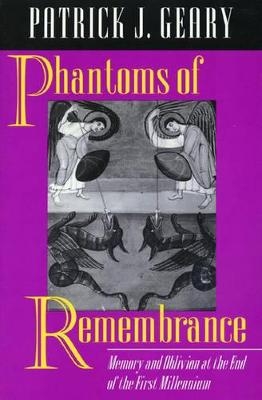
Phantoms of Remembrance
Memory and Oblivion at the End of the First Millennium
Seiten
1994
Princeton University Press (Verlag)
978-0-691-03422-5 (ISBN)
Princeton University Press (Verlag)
978-0-691-03422-5 (ISBN)
- Titel ist leider vergriffen;
keine Neuauflage - Artikel merken
This is a study of historical memory, evoking the everyday lives of 11th-century people and both their written and non-written ways of preserving the past. Through descriptions of various acts of remembrance, the book unearths a wide range of approaches to preserving the past.
This text makes important inroads into the widely discussed topic of historical memory, evoking the everyday lives of 11th-century people and both their written and nonwritten ways of preserving the past. Women praying for their dead, monks creating and recreating their archives, scribes choosing which royal families of the past to applaud and which to forget - it is from such sources that most of our knowledge of the medieval period comes. Through descriptions of various acts of remembrance, including the naming of children and the recording of visions, the author unearths a wide range of approaches to preserving the past as it was or formulating the past that an individual or group prefers to imagine. By focusing on a turning point in medieval history, one in which an effort was made to make a cultural break with the previous centuries, Geary offers an example of specific mental and social structures that filtered the memories communicated by social elites and ordinary individuals alike. The author focuses on the former Carolingian empire to compare how people from Provence to Bavaria recalled their familial, institutional, and regional pasts.
In examining written accounts and documents, he considers attitudes toward a wide range of topics - from gender and fashion to politics and religious practices - and shows how these attitudes reveal the social transformations taking place in the 11th century as well as the ways in which people had already begun to think about the past. Throughout his investigation, the author maintains that what matters is not so much the content of what is remembered but rather the ways in which memories are structured and represented, and ultimately what is forgotten along the way.
This text makes important inroads into the widely discussed topic of historical memory, evoking the everyday lives of 11th-century people and both their written and nonwritten ways of preserving the past. Women praying for their dead, monks creating and recreating their archives, scribes choosing which royal families of the past to applaud and which to forget - it is from such sources that most of our knowledge of the medieval period comes. Through descriptions of various acts of remembrance, including the naming of children and the recording of visions, the author unearths a wide range of approaches to preserving the past as it was or formulating the past that an individual or group prefers to imagine. By focusing on a turning point in medieval history, one in which an effort was made to make a cultural break with the previous centuries, Geary offers an example of specific mental and social structures that filtered the memories communicated by social elites and ordinary individuals alike. The author focuses on the former Carolingian empire to compare how people from Provence to Bavaria recalled their familial, institutional, and regional pasts.
In examining written accounts and documents, he considers attitudes toward a wide range of topics - from gender and fashion to politics and religious practices - and shows how these attitudes reveal the social transformations taking place in the 11th century as well as the ways in which people had already begun to think about the past. Throughout his investigation, the author maintains that what matters is not so much the content of what is remembered but rather the ways in which memories are structured and represented, and ultimately what is forgotten along the way.
Patrick J. Geary is Professor of History and Director of the Center for Medieval and Renaissance Studies at the University of California, Los Angeles. He is the author of Furta Sacra: Thefts of Relics in the Central Middle Ages (Princeton).
| Erscheint lt. Verlag | 6.11.1994 |
|---|---|
| Zusatzinfo | 3 Maps |
| Verlagsort | New Jersey |
| Sprache | englisch |
| Maße | 152 x 229 mm |
| Gewicht | 539 g |
| Themenwelt | Geschichte ► Allgemeine Geschichte ► Mittelalter |
| Geisteswissenschaften ► Geschichte ► Regional- / Ländergeschichte | |
| Geschichte ► Teilgebiete der Geschichte ► Kulturgeschichte | |
| ISBN-10 | 0-691-03422-2 / 0691034222 |
| ISBN-13 | 978-0-691-03422-5 / 9780691034225 |
| Zustand | Neuware |
| Haben Sie eine Frage zum Produkt? |
Mehr entdecken
aus dem Bereich
aus dem Bereich
eine neue Geschichte des Mittelalters
Buch | Hardcover (2023)
C.H.Beck (Verlag)
38,00 €


